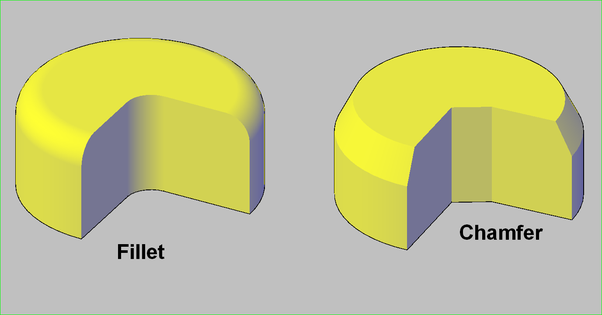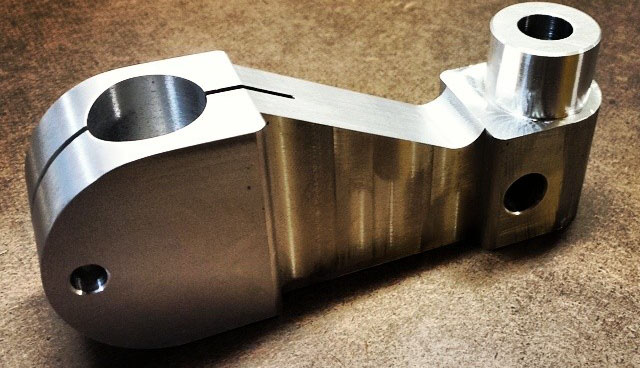In the process of CNC machining parts, in addition to sharp corners (which are regular geometric figures between two connected surfaces or vertices), you can also choose to design the corners as chamfers or fillets.
Understanding the difference between these two phenomena is actually a basic factor that designers must consider. This is because the choice made will determine the success or failure of the part manufacturing, and also affect the machining cost of the part to a certain extent.
Including fillets and chamfers in your design may incur additional CNC machining costs and sometimes reduce production speed. It is important to weigh these and other factors before deciding whether to include chamfers and fillets in a part design.
This article will explain the conceptual information about fillets and chamfers, their advantages and disadvantages, and precautions when designing and using them.

What Is Chamfering?
A chamfer is an oblique or angled side or corner of a part design. It is the opposite of rounded corners. The chamfer is not a curved shape, but is straight and has an acute angle. The chamfered edge is inclined or angled to reduce the influence of the sharp corner and improve the fit of the mating parts.
Generally, the function of chamfering is to remove burrs. Some installation processes require special emphasis on chamfering, such as installation guidance, reduction of stress concentration, and ease of assembly.
What Is Fillet?
There are different definitions of rounded corners. However, in part design, the machinist refers to the rounded corner as the rounded part of the inner or outer edge of the design. The rounded corner design requires rounded edges, eliminates all sharp corners and contributes to the appearance and service life of the component.
They are three types of fillet mechanics: miter, concave, and convex fillets. On the inside, the rounded corners are concave, while on the outside, they are convex. Engineers use rounded corners to reduce stress on the parts. Therefore, the rounded corners help distribute the stress on a larger surface and prevent rapid deformation of the compressed part.
When the design needs to eliminate sharp edges and low stress concentration, fillet engineering is the best choice for machinists.

Advantages And Disadvantages Of Chamfers And Fillets
Due to the rounded edges of the rounded corners, the physical stress of the rounded corners is distributed to a wider area, and the stress concentration factor is lower, which helps to improve the assembly of CNC machined parts and mating parts. The rounded corners can easily bear larger loads. Rounded corners are usually safe and durable.
The smooth edges created by the fillets can also be coated and painted more easily. In contrast, chamfering will cause the coating to follow the angle, and it will fall off over time.
Although chamfers are more prone to natural wear due to their sharp edges, these edges are hidden and therefore much safer than corners. When assembling mating parts together, chamfers are also more forgiving than fillets-they are particularly suitable for allowing male parts to easily enter female parts during assembly, because the chamfered holes allow smooth movement and insertion. More importantly, chamfers can be applied quickly and easily, because one tool can create chamfers of various sizes.
What Should Be Paid Attention To When Using Chamfer And Fillet For CNC Machined Parts?
To make it easier for you to understand whether the product design includes chamfering or fillet, you should consider many factors. From the aspects of CNC machining parts function, position tolerance, cost and so on.
1. Function
Remember the end use of CNC machined parts products. Are sharp edges and corners easy to damage the environment? Will the part be used for load-bearing applications, and if so, how much weight must the CNC machined part bear? Consider whether the function of the product depends on the presence of chamfers or fillets.
For example, does the part need to be painted or coated, and does the varnish need to be worn for a long time? Does the component need to be exactly matched to the mating part, or is there some leeway? Answering these questions will help determine which corner you should use.
2. Location (Internal And External)
It is important to consider whether the corner you are designing is inside or outside the CNC machined part. In most cases, it is more important to fully consider the outer edges because they are more conspicuous, more susceptible to external conditions and wear over time.
However, when designing a hole suitable for the shaft, it is also important to consider chamfering or filleting inner corners. It is recommended to chamfer along the edge of the hole, because the chamfered hole helps to move the pin and make it easier to insert the fastener.
3. Tolerance
Optimizing dimensional tolerances is a key part of product design, especially when machining parts with CNC. Determine the accuracy your product needs to achieve, and how incorrect measurements will affect the product’s functionality and fit.
In addition, ask yourself the importance of tolerances to ensure the performance of CNC machined parts, and consider how to check the tolerances. Keep in mind that applying extremely tight tolerances can be expensive, and chamfering usually allows a larger margin of error.
4. Cost
Applying chamfers and fillets can be expensive. Take a moment to consider whether rounding or chamfering is the key to the success of CNC machining parts, or just an additional benefit. If you really need a dedicated corner, please consider how many parts you need to produce, because this will also affect the cost of CNC machining parts.
Conclusion
Understanding the question of “what are fillets and chamfers” should not be a confusing question. You can use the two for different purposes according to your needs. However, choosing the right product for your design is one of the most important decisions when designing a part. This is because the right choice makes such a design more efficient, cost-effective and lasting longer.


